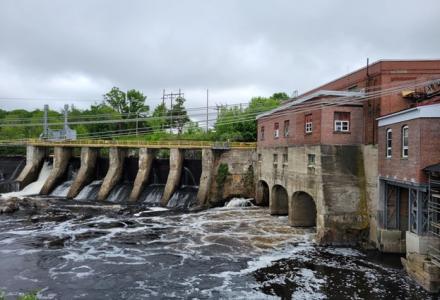
The 138-year-old Milltown Dam, located near the mouth of the St. Croix River between Calais, Maine, and St. Stephen, New Brunswick, is on course to be decommissioned and removed.
Milltown Dam’s removal is expected to restore the Salmon Falls on the river and permanently open up about 5 square kilometers (1.9 square miles) of spawning habitat on the Canadian side of the river for a variety of anadromous fish - species that live in the sea and return to the river to spawn - including alewives, American shad, American eels and Atlantic salmon.
Phil Landry, spokesman for dam operator New Brunswick Power, said Milltown has an operational fish ladder that alewives and shad use to access upstream spawning habitat. But that fish ladder needs rehabilitation work – as does the entire Milltown Dam operation.
The dam has seven hydropower generators that can provide up to 4 megawatts of power, but only four are working, Landry said. New Brunswick Power would have to spend “tens of millions of dollars” to get a bit more life out of the dam, as well as to upgrade the fish ladder. With the dam only providing 0.8 percent of the company’s hydropower portfolio, its rehabilitation is not financially viable, he said.
New Brunswick Power needs to seek Canadian and US approvals to remove the dam. The first step in the Canadian approval process will be to register the proposal for an Environmental Impact Assessment with the New Brunswick Department of Environment and local government. The registration documents will include details of the proposal, its potential environmental impacts and how significant impacts may be addressed. That filing, to be submitted in coming months, will kick off a formal technical review and consultation process.

Landry said New Brunswick Power held an open house July 11 in St. Stephen to hear public concerns so that those can be addressed in the assessment. While there were some concerns on how this might impact property values along the river, members of local organizations like the Atlantic Salmon Federation were upbeat and indicated that removed dams elsewhere rarely decrease values along rivers. There also were concerns about contaminated sediments being kicked up by the dam removal, which New Brunswick Power would need to manage as part of the decommissioning process.
Similarly, the company plans to continue discussions with the Peskotomuhkati (Passamaquoddy) Nation and local officials in St. Stephen and Calais. Landry added that they are still determining approvals required from state and federal resource agencies on the US side of the St. Croix River.
The provincial environmental impact assessment should be completed by the end of 2019. If all goes well with the approval processes, Landry said the decommissioning process could start as soon as late fall 2020, with an estimated completion time of early 2022. The details of the removal process will be fleshed out during the approval process, he added, noting that the dam was constructed differently from modern dams so the demolition needs to be determined based on that.
The Peskotomuhkati Nation said in a statement it is “deeply encouraged” by the decision to remove the dam and restore Salmon Falls. The restoration has been a priority of the nation in discussions with the federal and provincial governments and is viewed as an acknowledgement of the nation’s traditional territory.
The Peskotomuhkati people relied on fish runs in the river for centuries before Milltown and other dams were built. Ed Bassett of the Passamaquoddy Tribe at Pleasant Point said last year that prior to the dams, millions of fish would move up the river, providing food for people and other fish, animals and birds, including the American bald eagle. Alewives in particular have a cultural and spiritual role among the Peskotomuhkati people.
Milltown dam, which was constructed in 1881, is the oldest hydroelectric dam in Canada, as well as the first hydroelectric facility built by New Brunswick Power. It was an existing structure when the Boundary Waters Treaty of 1909 came into effect; when a portion of the dam was reconstructed in the 1930s the IJC issued conditions for operation in a 1934 Order. The International St. Croix River Watershed Board reports to the IJC on the operation of the dam and will be learning more about how the dam’s removal will impact water levels, flows and the ecosystem. As the domestic process is followed in both countries, the IJC will consult with the Canadian and US governments as required on the proposed removal.

Kevin Bunch is a writer-communications specialist at the IJC’s US Section office in Washington, D.C.




